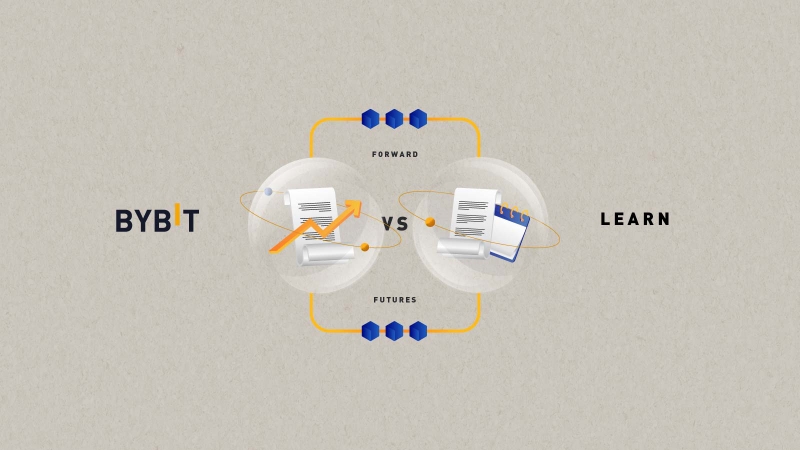Forward Contracts vs. Futures Contracts: Which Should You Choose?
Show More
Quickly grasp the article's content and gauge market sentiment in just 30 seconds!
You may be surprised to know that the concepts of forward and futures contracts, popularized by the stock market in modern times, have been around since ancient Greece. As the crypto market continues to grow and garner mainstream acceptance, these derivatives have come to play a key role in its growth. Perhaps one of the best indicators that an industry is growing is the introduction of tradable derivatives that aid in price discovery. To this end, let’s discuss what forward and futures contracts are, and which option is more suitable for you.
What Are Forward Contracts?
Forward contracts are agreements between two parties to buy or sell a specific quantity of a product based on a set of predetermined terms, where payment and delivery of the product are completed later at a set date. The terms of each contract are negotiated by the individual parties involved. Since a forward contract is concluded outside of exchange trading, it’s often referred to as an OTC (Over The Counter) transaction.
What Are Futures Contracts?
Futures contracts are transactions traded between two counterparties — the buyer and the seller — in an organized and regulated futures market. When purchasing a futures contract, the holder is obliged to buy or sell the underlying asset at a predetermined price (the settlement price) and at a certain time (the settlement date). Unlike forward contracts, which settle once (at the end of the contract), the value of a futures contract is determined daily based on market prices. Futures are strictly regulated and traded exclusively on established exchanges.
Contract components of futures contracts are the “underlying,” the contract size, the delivery agreements, the delivery month, the price, and position limits. The exact contract contents of futures are determined by the exchange on which the contract is traded.
With a forward contract, it’s possible to hedge against future price fluctuations. When taking a short position, the holder of the forward contract can hedge against falling prices. In contrast, a long position in a forward contract allows the holder to hedge against rising prices.
In currency markets, forward exchange contracts can be used to buy or sell a currency, whereby the fulfillment of the transaction in the future takes place on currently agreed terms, at a specified price. In addition to speculating on changes in exchange rates, forwards also make sense if companies want to hedge the exchange rate risk for future transactions in a foreign currency. With the help of forwards, a company can secure a currency at its present exchange rates, for which the delivery fee is to be paid at a future date.
What Purposes Do Futures Contracts Serve?
Like forward contracts, futures are used for speculation and hedging. Originally designed for agricultural markets, the primary role of futures contracts is to minimize the risk of losses related to fluctuations in the price of the asset to which they relate (this is the role of “hedging”).
Since futures contracts are traded on official exchanges, they serve two important roles that forward contracts do not. First, they aid in the process of price discovery. At any given time, futures quotes represent a consensus of opinions on the price that the underlying product will reach at a certain date. Secondly, they increase the liquidity of otherwise illiquid assets in the financial markets, allowing for the execution of large orders while limiting price fluctuations.
What Are the Differences Between Forward and Futures Contracts?
The following are the three primary differences between forward and futures contracts.
Transaction Method
Futures contracts are traded on formal exchanges and are standardized, with exchange-specified contract size, tick size and nominal value. In contrast, forward contracts are privately negotiated and tailor-made according to the counterparties’ preferences. Note that futures are priced based on prevailing market valuations, and that contracts can be actively traded.
Risk Level
Futures have no counterparty risk because the exchange’s clearinghouse guarantees payment. Moreover, the trading and pricing of these contracts are actively regulated by financial authorities. In essence, the clearinghouse functions as the counterparty for both buyer and seller.
On the other hand, forward contracts pose a credit default risk because they’re privately negotiated, and completely dependent on the other party’s payment.
Contract Maturity
Futures contracts have fixed maturity dates which are set at regular intervals by the exchange. The maturity for forward contracts, on the other hand, can be set for any date, depending on the agreement between the parties involved.
Futures and Forward Contracts in Cryptocurrency
When it comes to a forward or futures cryptocurrency contract, there are two ways a trader can position themselves:
- The trader may want to sell the contract by taking a short position. They speculate that the price of a cryptocurrency will drop.
- Conversely, the trader may want to buy this contract by taking a long position. This position bets on the rise in the price of a cryptocurrency.
Crypto Forward Contract Example
As mentioned earlier, forward contracts can be as informal as we want them to be. Suppose you hold two BTC in your wallet, and the current price of a BTC is $44,700. Given the current market volatility, you believe that its price will drop significantly in about six months. Thus, you decide to enter into a forward contract to sell your BTC holdings at $89,400.
After six months, you’re obligated to sell your two BTC at $44,700 each, regardless of prevailing market conditions. If by then the price of BTC is lower than $44,700, you’ll benefit by pocketing the difference. However, if the price is higher than that, you’d lose out on potential profit.
Crypto Futures Contract Example
Let’s say a trader buys a futures contract whose underlying is three bitcoins worth $135,000 in total. Before becoming the contract owner, he’ll have to pay a security deposit to the exchange as collateral. The value of the security deposit corresponds to 10% of the value of the contract, which in this case is ($135,000 × 10%), or $13,500. Once the deposit is made, the trader takes a long position, betting on the rise in the price of Bitcoin compared to the purchase price ($135,000).
Each exchange sets its own tick value (the minimum price fluctuation for each contract), with the average being $10. This means that upward or downward variations of less than $10 will not be taken into consideration. These variations below the tick do not lead to loss or gain. If the price of Bitcoin increases by 5 ticks — i.e., (5 x $10), or $50 — the trader with the contract on three Bitcoins earns (3 x $50), or $150. If the price falls by $50, in the same way the trader will lose $150.
Upon maturity of the contract, if the price of Bitcoin has increased by 10%, the trader will earn $135,000 x 10%), or $13,500. Therefore, our trader has earned 100% of his initial deposit and doubled his bet. The trader is left with $27,000. (Had he bought Bitcoin with the same amount of money — instead of making his leveraged trade — he would have ended up with $13,500 + ($13,500 x 10%), or $14,850 instead.)
On the other hand, if after six months the price of Bitcoin drops by 20%, then upon maturity our trader will have lost 120% of his security deposit. As such, the $13,500 that was placed as the deposit will be forfeited. Additionally, the trader will owe the exchange 20% of the deposit: $13,500 x 20%, or $2700. This process is called a margin call. Futures contracts initiate margin calls to cut losses when things spin out of control.
Fees Involved
Typically, there are no fees associated with forward contracts.
In contrast, every crypto exchange sets its maker and taker fees for futures contracts. The futures contract fees vary, depending on the crypto exchange. Apart from this, there are also margin fees and collateral requirements. Always check for fees on your crypto exchange before trading a futures contract.
Which Is Better: Forward or Futures?
Arguably the greatest advantage of forward contracts is the ability for counterparties to customize an agreement however they like. These contracts can be as informal as they wish, and can also be drawn for just about any asset or price. For futures, the exchange determines the contract size, as well as the number of underlying assets to be delivered. The delivery agreements include the place and mode of delivery, both of which are also determined by the exchange. When specifying the delivery month, the exact period in which the delivery will take place must also be indicated. Also, clearinghouses eliminate any counterparty risks that may arise.
The Bottom Line
The purpose of forward and futures contracts is to allow the negotiation, purchase and sale of any asset to take place in the future. These contracts are derivatives, because their price depends on the evolution of the spot prices of the property to which they relate — known as the “underlying.” Thanks to leverage, they can be used for two purposes: to make the most out of a profit opportunity, or to hedge your portfolio against a price risk at a lower cost. Derivatives markets allow an investor to speculate or hedge their risk without a large down payment, offering them the opportunity to open a position and liquidate it easily at a lower cost.
It is our hope that the information contained in this article will help guide you toward your decision. Ultimately, it’s your call regarding which of the two contracts to trade.
Grab Up to 5,000 USDT in Rewards
Get additional 50 USDT welcome gift instantly when you sign up today.



